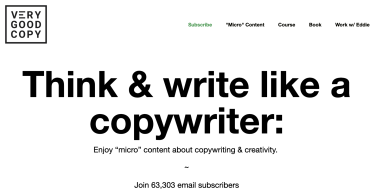
How to Craft a Winning Content Mission Statement

Between endless marketing channels, new technologies, and responsibility overload, it’s easy for businesses, large and small, to lose sight of the big picture. As a content marketer in this busy world, you need to regularly step back, look up from the weeds, and think about your strategic goals. To do this, and to do it consistently, you need a content mission statement.
What is a content mission statement?
| In the most basic terms, a content mission statement explains why you do what you do, content-wise. It’s a pledge to yourself and your customers. It’s the reason you create each and every piece of content, and it’s the light that should guide your content strategy and daily efforts. |
So, before debating which social channels and white paper topics you need, think top-level about your audience’s priorities, your unique value proposition, and why your brand matters to your customers.
The anatomy of a winning content mission statement
While content mission statements come in all shapes, sizes, and flavors, the most effective statements answer these questions:
- Who are you speaking to — who is your target audience?
- What do you offer and are qualified to give your audience?
- Why should your customers care — what's the grander purpose?
At Acquia, the mission statement for our digital asset management (DAM) blog content is:
“Where marketing and creative teams find actionable advice, practical resources, and success stories to flourish in a world connected by content.”
As you can see, we clearly and directly set expectations around:
- Who our content is for: marketing and creative teams
- What we provide: actionable advice, practical resources, and success stories
- Why it matters: so our audience can flourish in a world connected by content
A winning content mission statement is half substance, half application
Sticking with the who-what-why template is a great place to start, but there’s more to a successful content marketing mission statement than words. You also need to leverage your statement in a way that helps you connect and communicate with your audience.

Take this content marketing mission statement example from Very Good Copy, a blog and newsletter about copywriting, marketing, and creativity. They pack their mission statement with all the substance we talked about, and they put it to work through:
- Transparency. It’s displayed for all to see across their website, including their home page which serves two purposes: to capture signups and set audience expectations about their content offering.
- Branding. Their statement is very direct and to the point — just like their micro-articles, micro-interviews, and overall copy style.
- Authority. They back up their mission statement with quotes from notable readers throughout their site and content.
- Differentiation. Instead of filling their about page with “marketing language,” Very Good Copy lets their readers and subscribers speak for them with almost 90 testimonials on the page and very little marketing copy.
As with any marketing exercise, you can approach a content mission statement as just another task to tick off, but doing so is unlikely to make an impact on your audience or your team. It should instead be seen as a key piece of the content marketing foundation.
Why is a content mission statement so important?
In the blur of fast-paced marketing workflows, it can be all too easy to focus on content quantity over quality. After all, content is continually needed to create relevant, personalized experiences for customers, wherever they are in their brand journey. A content mission statement serves as a North Star that helps teams align on messaging and ensure that content is created with a shared purpose.
Your content mission statement can also serve as a barometer to review and approve new content requests, as well as ensure alignment with your overarching strategy. This makes saying yes or no (or giving feedback) to requests easier and more intentional.
Maintaining focus and purpose
Once you establish your content goals, it’s important to uphold them. If your audience expects one thing but receives something else, it can erode their trust and confidence in your content. Although it can be tempting to dabble in different areas, remember that straying too far from your mission statement can be distracting.
Consistent messaging
Ideally, all content would be written — or at least reviewed — by the same team before going out into the world. But this isn’t always possible, especially if you’re creating content at scale. Providing a content mission statement backed by strong copy and messaging guidelines will help teams deliver consistent content no matter their role or location. (And we strongly recommend a dedicated editing process as well!)
Standing out from the competition
If everyone can come up with a content mission statement, how do you stand out? This is where you let your brand’s personality shine! A defined tone and voice, an aligned brand essence, and strong brand guidelines will set you apart from the competition. Being able to activate all of these elements consistently across your company and brand will make a world of difference when it comes to differentiation.
Final thoughts
An outstanding content mission statement is more than a declaration; it’s a way of life. It will challenge you to learn more and more about your target audience, so you can create better content day after day. And it will motivate you to stay focused and inspire you to do more. At the end of the day, it’s not only how you define your content mission, but how you leverage it — and your team — to get the right content, to the right people, at the right time.
There are a few tools that can facilitate that outcome. A digital asset management (DAM) solution, for instance, can help drive content operations and support your content mission statement. Acting as a central hub for all your brand assets, a DAM platform ensures teams companywide can access the most up-to-date resources — from catalogs and product videos to white papers and more — so your content and communications are always on brand.
Another tool of critical importance is a content management system (CMS). Many organizations are familiar with the technology but may not be aware of recent advancements that make today’s versions more powerful than ever before. An open source platform like Drupal, for instance, features a customizable editorial interface with numerous widget options, tabbed sections, and accordion layouts that make life easier for content authors seeking to fulfill your organization’s content mission. And when you use a low-code site builder alongside Drupal, anyone within an organization can create and publish on-brand web pages quickly without having to go through a development team. That capability accelerates time to market and ensures organizations can deliver content quickly, a must in a content-hungry world.
Having a customer data platform (CDP) adds another key weapon to your content arsenal. Because a CDP centralizes all customer data in one place, it offers a 360° view of your customers, with insights on individuals and segmented groups that improve personalization efforts. By knowing your audiences’ preferences, you can align the content you serve with their interests and your content goals.
To learn how Acquia can help you bring these solutions together in a composable digital experience platform (DXP) that supports your content mission, request, watch, or click through a demo today!


